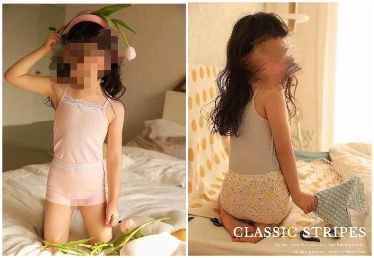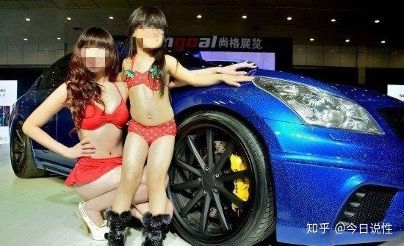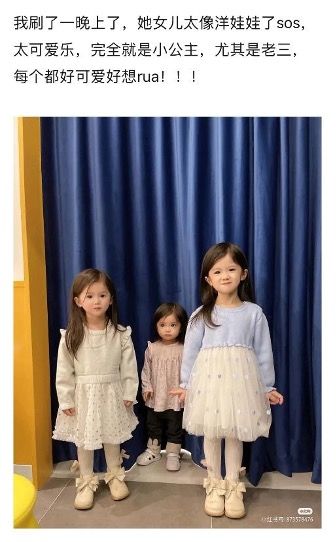girl model being peddled on the shelf

Text|Almond Dew for Flower Viewing
A few months ago, some netizens exposed a Taobao store for children's underwear. In the ad, the girl model poses in sexually suggestive poses in panties and a tank top, with the underwear outlining the shape of her genitals. These advertisements suspected of being a pedophile have aroused heated discussions on the Internet. The store's response to this was: "People with unhealthy minds look at everything dirty."
After being reported by netizens, the store has removed these photos and replaced them with pictures of products without models.


Is this Taobao store specifically offering "benefits" to pedophiles to make a profit? Not really. The industrial chain of child pornography is often socialized, hidden and lucrative. As an e-commerce platform, Taobao, even if the store can attract attention through pornographic pictures of child models, cannot directly monetize the traffic. Instead, it is easy to be reported by children's parents.
Therefore, we can reasonably suspect that the store owner applied the shooting mode of adult underwear advertisements to children's underwear advertisements largely out of inertia, and projected the male gaze in female adult underwear advertisements onto girls. And girls are a group that is clearly stipulated by law and cannot be sexualized morally. The irrationality of this action is immediately highlighted.
It is only when the girl model is inappropriately sexualized that people realize that the role of underwear itself is to maintain hygiene and provide privacy, not necessarily ornamental - and the ornamental quality of underwear is precisely in the adult world. Normalization is even defaulted.
The spread of the adult world
Such incidents are no coincidence: at a certain auto show, several models of children's cars in bikinis posed in various poses under the flashing lights. The girls are around four or five years old and appear alone or with adult bikini models. In the face of accusations of promoting child pornography, organizers have argued that it was at the request of parents and that they were simply "providing a platform to show their children's confidence."

Recently, a children's clothing store on Douyin was scolded by netizens for "attracting pedophiles" for designing dresses such as strapless and deep V-necks for girls. However, some people pointed out that it is not the problem of children, but the tailoring design of adult women's clothing itself places women in the position of sexual objects, highlighting the curves of the body. Adult women have become accustomed to and even embraced this arrangement. By contrast, boys don't look weird in smaller versions of men's clothing.

Once the sexualization of children is mentioned, the public, out of anger, often attribute the object of condemnation to "irresponsible parents", "profit-seeking platform merchants" and "perverted pedophiles". It happened only as a result of the moral downfall of "a subset of people". But the above examples of child models just show that the sexualization of girls is not groundless, but just the spread of the female gaze in the adult world that has long been rationalized. Girls are not specifically hunted by capital and patriarchy, but the net is getting bigger and bigger, involving them all—and only then do people begin to reflect on society’s collective objectification of all women.
The organizers of the auto show explained that the use of girl model car models, "they are just showing their bodies with confidence," has also been repeatedly used to cover up the exploitation of women in the porn industry and the encouragement of female competition. And who is being shown? Where does the so-called self-confidence come from? Women need to fight for the right to not have to wrap their bodies in layers, but there is a question mark on whether it is necessary to "show sexiness and beauty" as an empowerment.
She has no freedom not to be beautiful
The last time the rights of child models came into the public eye was the child abuse incident in Zhili, Zhejiang in 2019. As the "hometown of children's clothing in China", Zhili has gathered thousands of child models and provided nearly 90% of children's clothing model photos on Taobao. Here, the popular child model costs 100 yuan for each set of clothes, and the shooting time is from 9:00 am to 5:00 pm. About 30 sets of clothes can be photographed a day, and there is an income of 3,000 yuan. Niuniu, who was kicked by her mother in the child abuse video for not cooperating in taking pictures, is one of them. Under her mother's dressing and transformation, she has become a beautiful daughter and a popular child model since childhood.
Wang Ya, Niuniu's mother, said that she had planned her daughter's future before she was born: "I must let her learn the piano and dance", "buy her beautiful clothes, how to look good and how to dress up".
Wang Ya bought a lot of clothes for her daughter, photographed them from different angles, and wrote the buyer's show word by word. As a housewife, she was "too free at that time". There are more than 20,000 photos stored in her mobile phone, and they are uploaded to cloud disk and QQ space by category. This has also become an opportunity for Niuniu to embark on the road of child model.
Under the fierce commercial competition, all the girl models in Zhili, represented by Niuniu, could not escape the fate of becoming delicate dolls at the mercy of others: perming their hair, taking pictures with makeup, wrapping their tummy with a waistband, cutting their eyelashes to make them look good. The newly grown eyelashes became thicker and curled, and pinching the bridge of the nose made the bridge of the nose stiffer (many ordinary women also said that their parents did these things to them when they were children)... More importantly, the tight shooting arrangements made them repeatedly delay their studies and rest.
The child models in Zhili gained public attention because the video of Niuniu being beaten showed a selfish mother who treated her child as a cash cow, causing public outrage. But accusing a struggling housewife of selling her daughter's looks is tantamount to questioning why sex workers are "falling themselves to the ground" while ignoring the people who really make it happen. It is the public's pursuit of delicate and beautiful little girls and put them on the shelves.
Everyone is a gazer
The erotic culture in the patriarchal society often embodies the discourse of power and domination. The emergence of pedophilia is often based on the dual weakness of children's physical strength and mind. This echoes with today's adult women's aesthetic pursuit of young teeth and thin body. On the one hand, adult women take the initiative to show their sexuality without being aggressive and easily dominated; on the other hand, girls "actively" make erotic gestures without knowing it. The blurring of the lines between the two has resulted in the image of the girl child becoming more and more associated with pornography, and the person who is in heat with the girl no longer sees himself as the dominant party, but instead sees the other as a precocious seducer.
If the sexualization of children by media platforms can be immediately detected and stopped under the constraints of morality and law, then the gaze on women’s appearance is irrespective of age, and it often does not arouse the resentment and reflection of adults.
Nowadays, on self-media platforms such as Xiaohongshu and Douyin, more and more parents (especially mothers) dress up their daughters to attract fans, and the comments they get are often full of admiration and envy. It's only when some bloggers go too far, like perming their young daughters, that criticism is raised.
Searching for "daughter" on Xiaohongshu, the posts that appear are all photos of girls wearing skirts, long hair and delicate looks. The text also mainly emphasizes the sweetness and cuteness of girls. When searching for "son", there are far fewer posts dedicated to the boy's appearance. Even if there are, they are often infants and young children. After all, boys do not have as many templates for dressing up as girls when they grow up. The blogger's descriptions tend to focus on day-to-day interactions with his son, or outright pride in having a son.


Radical feminists in South Korea once put forward the concept of "corset", which generally refers to all items that are used to decorate a woman's appearance and body, but it will bring inconvenience to daily life and waste women's energy, such as: long hair, cosmetics, uncomfortable items or clothing with limited mobility, etc. Now the corset has been put on the girl's body by adults in a chorus of praise.
Netizens who praise beautiful girls in the comment area obviously have no malice, let alone pedophiles. But how far is it between these sweetly dressed daughters and the child model Niuniu? If there is no accidental exposure in the media, Niuniu may be just a beautiful figure on the billboard now, and the parents of other girls will praise her cuteness and pay for it. Similarly, netizens who contributed traffic to the beautiful daughters on Xiaohongshu, while sincerely loving these children, sought after them as commodities.
When women become the carriers of resources
In a patriarchal society, women are inherently carriers of resources. Some resources are given naturally, such as fertility; others are constructed, such as appearance and sex—even though the five senses and sex organs are innate, it is a man-made process to assign value to them. Women become the object of appreciation and estrus, and need to actively maintain their own admiration, which is an oppressive arrangement in itself. It is worth noting that women themselves have begun to internalize this arrangement into their values and actively participate in the gaze.
Sleeping with a flat head, pinching the nose, and scraping out the double eyelids with a spoon are the mother's fault for her daughter as a potential resource on behalf of the patriarchy; the praise of the doll-like little girl on the media platform is an adult (often an adult woman) in the The inclusion of children in the process of gazing at the object; narratives such as "dressing up makes me more confident" are women's "voluntary" objectification of themselves.
The term "male gaze" often makes people mistakenly believe that only men can act as the subject of the gaze, or that only dressing that conforms to traditional male aesthetics is worthy of reflection and rejection. In fact, any form of giving value to appearance and body is the objectification and resourceization of people. Sometimes it doesn't even require the participation of male gazes, and a misogynistic carnival of "appearance first" can be completed within the female group.
For the disenfranchised party, possession of resources does not mean an advantage in making a living, but instead provides others with an incentive to plunder—this plunder is often legitimately and legally carried out in the form of “take first, then exchange.” Just as marriage, surrogacy and prostitution cannot be seen as economic empowerment of women, they are the result of the disempowerment of women at the bottom. They have no freedom not to exchange.
In a patriarchal society, women are forced to enter marriage or the market with the inclination of inheritance rights, education rights and work rights in exchange for their fertility, housework and sexual value. This arrangement is sometimes mistaken as a gender bonus for women, and because of this, young girls are not given the expectation of "relying on their own abilities to compete for resources" when they are nurtured and educated by their parents, such a vicious circle.
In the past, the "bonus" brought by appearance can only be realized in marriage and love, so girls are not encouraged to put too much energy into appearance (the school does not want students to affect their academic performance). Now, with the self-media platform and the child model industry, parents who manage appearances for their daughters have cashed out this "bonus" earlier and more stably. The price behind the expectation that a girl is born with the expectation of profiting from her appearance must be that her parents no longer treat her in the way of "cultivating competitive talents", which is not only a manifestation of her powerlessness as a child, but also her powerlessness as a woman. the beginning of.
Beauty is useless
Appearance labor has sunk from adult women to girls, and it is not only reflected in some girls who are used as cash cows by parents and businesses. Now on station B, a group of primary school beauty makeup bloggers have gathered to teach their peers "how to wear nude makeup that teachers can't see in school" and "11-year-old girls' dressing rules". We can already see the tendency of girls to take the initiative to perform physical labor no longer for economic gain, but simply because of cultural coercion.
In order to break the vicious circle that women of all ages spend their energy and money on physical labor, and may be forced to sell their beauty after losing their economic power, feminists put forward the "beauty useless theory". Since the value of beauty is artificially assigned, what we can do after realizing the harm caused by possessing and maintaining beauty to women is to actively deconstruct this value and re-establish an evaluation system for women - a system based on "people" instead of A way of looking at things based on the standard.
When we praise a girl as "beautiful and sweet", we have recognized the expectations of patriarchal logic on women and reduced her to an object for appreciation; when we consume her appearance in whatever form, it is Put her on the shelf.
But this deconstruction of the value of beauty is only ideological. It allows feminists to start from themselves, abandoning the servitude of their own appearance and the gaze of other women, but it cannot eliminate the existence of the male gaze and the economic benefits that come with it. The patriarchal society's pursuit of women's appearance and capitalism's encouragement of appearance servitude are two mutually reinforcing logics that put more and more women on the shelves and virtually deprive them of the right to choose other paths.
Like my work? Don't forget to support and clap, let me know that you are with me on the road of creation. Keep this enthusiasm together!